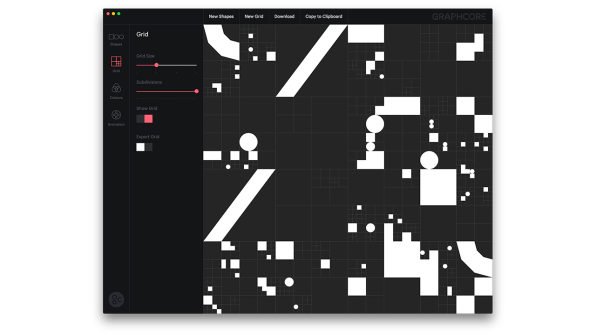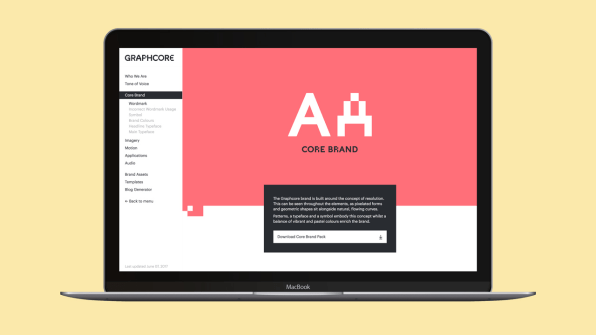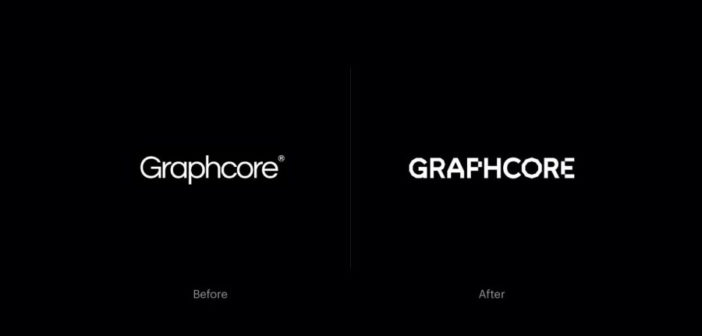Pentagram brands an AI processor startup demonstrating its smarts, and without tech tropes.

James Cameron did the world a terrible disservice with The Terminator. Even today, society defines cutting-edge technology by steel and glowing red LEDs. And so most of us cannot distinguish the logic of machine learning from the world-ending singularity.
“It’s super dystopian,” says Jody Hudson-Powell, partner at Pentagram. “It’s dark sci-fi stuff. Machine learning isn’t dark sci-fi stuff. It’s technology that’s really going to [positively]impact people’s lives.”

So along with his brother, Luke Powell, a fellow Pentagram partner, Hudson-Powell co-led a brand design for the machine learning processor startup Graphcore—one not based on scary imagery or nonsensical Hollywood theatrics, but the logic that drives neural networks, artificial intelligence, and machine learning.To brand these oft-invisible concepts will be one of the biggest challenges for graphic designers over the next 5 to 10 years. What is a neural network? It’s essentially a brain built from servers or software. What is machine learning? It’s a process by which computers chew data to adopt a new skill. And AI is often a string of equations known as an algorithm, but also a catch-all term that can encompass neural nets, machine learning systems, and basically everything that orbits this world. Even this short paragraph glosses over the nuance of each system in ways that will make a computer scientist’s skin crawl. Yet designers and marketers will need to summarize these ephemeral technologies in few words, using branding snapshots like logos and taglines to convey untold complexities.

“When we first got the job, we wanted to lean toward using neural networks and machine learning to create the assets,” says Hudson-Powell. “But the industry progress being made is so rapid, and the look of things is changing so fast, we almost had to take a step back.”Instead of considering the latest in neural network visualization–like fleshy semi-human faces or images drawn from dogs–Pentagram learned from Graphcore how these machines really think. Machines absorb knowledge by ingesting huge libraries of data. Case in point: A machine assembles the idea of a kitchen by spotting the sub-elements of a kitchen–a refrigerator, a stove, a sink. Only from these pieces does it understand the larger idea. (And the same logic applies as a machine analyzes the handle, silhouette, and doors of a refrigerator itself.)
“We realized . . . these low-resolution fragments of images are how a machine conceives the world, recognizing small objects, and pairing smaller objects up to make context,” says Hudson-Powell. “We’re interested in this idea of resolution, they can go from perfect and organic–our perception of the world–to break down to be more minute, pixelated fragments.”

In turn, Pentagram designed a new typeface for Graphcore. The typeface isn’t just a single string of letters, but a typeface with many versions of each letter, presented at various resolutions. The “O” might have four permutations, starting from blocky edges, all the way to silky smooth curves. Each letter’s use can be randomized or the font can be deployed differently for different messaging. If the purpose is to explain the impact of machine learning on people, and social situations, it can have more organic letters–bringing out its smooth, human side. If the purpose is to get into the nitty-gritty of the technology itself, breaking down how hardware and code mix, the text can be pixelated, emphasizing its technological prowess.On websites, Pentagram’s Javascript also can make the letters themselves change and flicker. “It’s the idea of sensing,” says Hudson-Powell, as the machine is really never done learning or reacting to data. “The system will never stand still.”
The next thing Pentagram did with the new font was to build it into a larger graphic generator. Using simple sliders, Graphcore can create new Graphcore-branded imagery. This web and desktop tool embodies the idea of machine learning resolution at another level, literally scaling the letters on a grid, with a randomness to color and layout that creates countless permutations of the brand identity.
Randomized tools, based upon custom algorithms, have been a mainstay in branding for some time. But for Graphcore, it’s important to the brand, as machine learning as an idea itself has been wrought with implicit bias. The people coding the machines–usually white men–have often created neural networks that are racist and patriarchal. Yes, men led the design of Graphcore’s brand and generative branding tool, too–but the designers hoped to create a randomized standard that, at minimum, could pull the industry away from the male-centric dystopias of killer robots, aliens, scantily clad ladies, knights, and whatever other branding the PC gaming industry adopted. Because it’s specifically PC gaming hardware that much of the machine learning industry is using today.
Of course, ridding one’s own implicit bias is harder than you think, even for Pentragram designers.
“You find some funny things,” says Hudson-Powell of the randomizer. “We talked about it being less masculine, but [our code]leads to pink. Is that leading to another bias, that pink means feminine? I don’t think that’s what we meant. [Pink] becomes more about lifestyle. It’s less masculine, but that doesn’t mean it has to become overtly feminine.
“At times, when it did become very pink, the client was very comfortable,” he continues. “If this does feel like a shift, then that’s a really positive thing. We’re leaning against the current.”
–
This article first appeared in www.fastcodesign.com
Seeking to build and grow your brand using the force of consumer insight, strategic foresight, creative disruption and technology prowess? Talk to us at +9714 3867728 or mail: info@groupisd.com or visit www.groupisd.com


